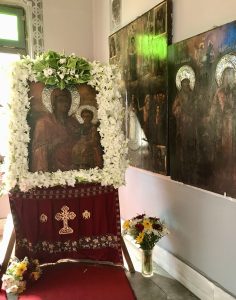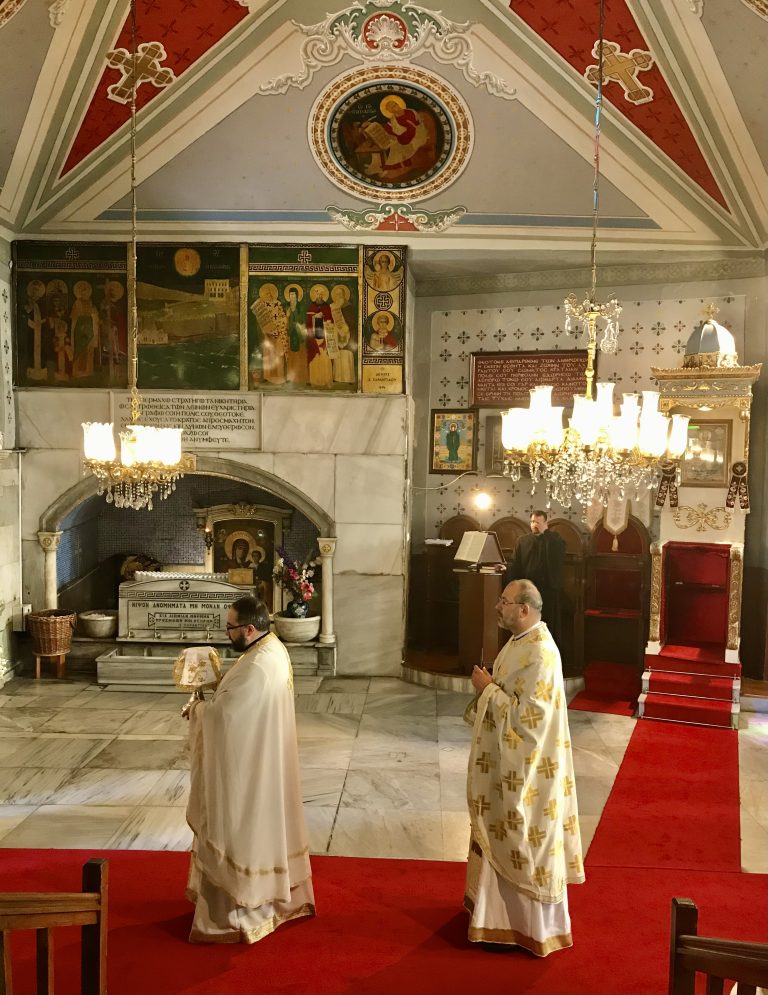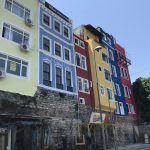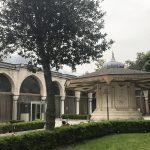“Palace with Iwans”
Festival: 2 July (St Mary’s)
Ayvansaray is the monument-rich and historically interesting corner where the old Sea Walls along the Golden Horn finally joined up with the Land Walls running downhill from Edirnekapı. Much rebuilding was done here in the period following the reinstatement of the Byzantine emperors in 1261 after the Latin Interregnum and some of the finest surviving towers along the walls can still be seen here dominating a small park and with a pretty little cemetery tucked up between them.
When they recovered power from the usurping Crusaders the Byzantine rulers found their old palace in what is now Sultanahmet in ruins. To replace it they expanded a small existing palace at Blachernae which had been built beside an especially important sacred spring. Little remains of Blachernae today although the Tekfur Sarayı may once have formed part of the complex.
At weekends a lively pigeon market takes place inside the walls in front of Tekfur Sarayı.
The Tokludede neighbourhood of Ayvansaray has been subjected to the same kind of enforced urban renewal programme which replaces poorer locals and their homes with luxury apartments for outsiders as Sulukule and Tarlabaşı but, as journalist Alexander Christie-Miller pointed out in his To The City, with much less international complaint.
Around Ayvansaray
To reach the great towers that rise up along the wall here you need to walk across the small park containing the small Hacı Hüsrev Mescidi, restored but believed to date back to the very end of the 17th century along with a pair of fountains and a cistern that formed part of a complex with it.
At their Golden Horn end the Walls still stand to a great height in two layers, the older built by the Emperor Heraklius in 627, the younger by Emperor Leo V (“the Armenian”) in 813.
Look for a gateway leading through the walls and into a hidden pocket of cemetery attached to the shrine of Ebu Şeybet-ül Hudrı. It was commissioned by Toklu İbrahim Dede who is thought to have taken part in the fighting for Constantinople in 1453 and who is buried here alongside two companions of the Prophet Mohammed, Hamidullah El Ansarı and Ebu Ahmed Al Ansarı. It stands close to the site of the lost Byzantine church of Aya Tekla, traces of which survived into the 1970s.
If you continue south-west along the walls you will see the dome and minaret of the İvaz Efendi Cami jutting up above the parapet. Built in the 1580s, İvaz Efendi looks as if it should be a work of Sinan although there is no reason to believe that it actually is. Internally its most intriguing feature is a gallery that is supported by a wooden colonnade that one might not have through strong enough to bear the weight of the dome. It also features pretty İznik tiles around its mihrab.
To reach the mosque you will need to head inside the walls and walk up Dervişzade Caddesi, passing the restored Emir Buhari Tekkesi, a dervish lodge that started life in 1513 but was completely rebuilt in the 19th century in austere style.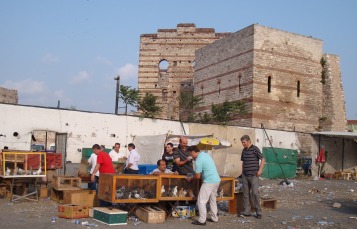 Pigeon market in front of Tekfur Sarayı
Pigeon market in front of Tekfur Sarayı
If you keep following the walls on their inner side you will come to the Anemas Zindanı (Dungeon), one of the few remnants of the Blachernae Palace. This originally dated back to c.500 when it was built for the Emperor Anastasius so that he could stay overnight when visiting the nearby shrine. In the 11th and 12th centuries the emperors expanded the palace complex, and when they were restored to power in 1261 they made it their base.
The Anemas Zindanı was to the Golden Horn end of the Sea Walls what Yedikule was to the Sea of Marmara end: a place where inconvenient men, including the odd emperor or two, could be locked and forgotten. A huge building, it has been undergoing lengthy restoration. Once the work is finished it should attract more visitors to this part of the Walls.

Tekfur Sarayı after restorationRight next door to the dungeon the other relic of the palace is the largely intact Tower of Isaac II Angelos who had it built in 1188, probably as a private apartment with a spectacular view of the Golden Horn from its balcony. Regardless, Angelos was deposed, thrown into the dungeon next door and blinded. In 1213 he and his son, Alexius IV, were briefly restored to power as co-emperors before being deposed, thrown back into the dungeon and then strangled.
Beyond the dungeon and tower a space opens out inside the walls right beside the Tekfur Sarayı, originally brick-built as the highly decorated Palace of the Porphrogenitus (“Born in the Purple”, a synonym for the Byzantine emperor) in the 13th or 14th century. After the Conquest in 1453 it served time as a private zoo and then a brothel, before, in 1719, being turned into a kiln which turned out Tekfur pottery until the end of the century. It has been restored to provide a museum (Closed Mondays, admission TL50) primarily telling the story of the pottery. There are great views of the Golden Horn from the walls.
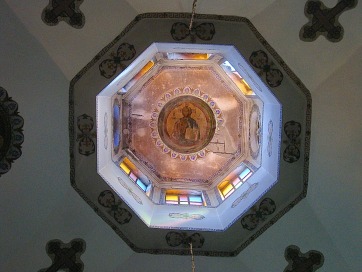 Although the Walls are the most conspicuous feature of Ayvansaray you shouldn’t leave the area without strolling back towards Balat in search of the Church of St Mary that stands over the site of the Blachernae ayazma (sacred spring). Today virtually ignored by non-Greek visitors, it was this site that provided the raison d’etre for the development of the Blachernae Palace complex. The ayazma seems to have been important even in pre-Christian times but became considerably more important after the first shrine was built here in 451 and even more so after it acquired relics of the Virgin Mary from Jerusalem.
Although the Walls are the most conspicuous feature of Ayvansaray you shouldn’t leave the area without strolling back towards Balat in search of the Church of St Mary that stands over the site of the Blachernae ayazma (sacred spring). Today virtually ignored by non-Greek visitors, it was this site that provided the raison d’etre for the development of the Blachernae Palace complex. The ayazma seems to have been important even in pre-Christian times but became considerably more important after the first shrine was built here in 451 and even more so after it acquired relics of the Virgin Mary from Jerusalem.
Then in 627 soldiers fighting to drive away Avar invaders reported a vision of the Virgin Blacherniotissa urging them on from the walls and the site was destined to become one of the most holy spots in Byzantium. The original church burnt down in 1434 and the existing model is a 19th-century rebuilt in a quiet walled garden. Visitors are still able to see the famous ayazma and drink some of its water.
In a side street running down to the water close to the Blachernae Church stands the Hazreti Cabir/Atik Mustafa Paşa Cami (Çember Sokağı), generally overlooked even though it started life as a 9th-century Byzantine church, as is abundantly obvious if you walk round the back to inspect the brickwork and the triple apse. The church was once thought to have been dedicated to Sts Peter and Mark although today there is less certainty about that. 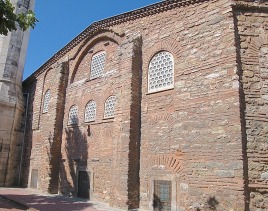 Hazreti Cabir Cami, once a Byzantine church
Hazreti Cabir Cami, once a Byzantine church
Transport info
The quickest way to get to Ayvansaray is by traim from Eminönü although the most pleasant way is to take the Golden Horn ferry from Üsküdar, Kadıköy or Karaköy. Frequent buses from Eminönü and Taksim also head for Eyüp passing through Ayvansaray although they may get stuck in traffic on the narrow coast road.
Nearby areas
Read about waking the Land Walls to Ayvansaray: Istanbul Wall Walking
